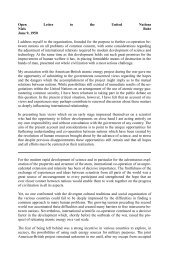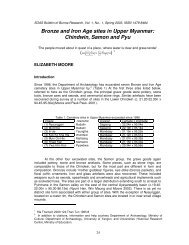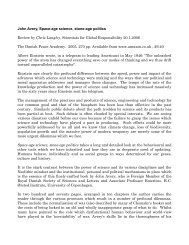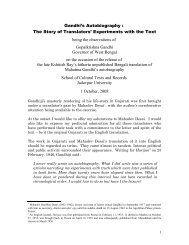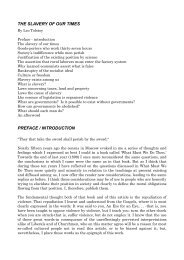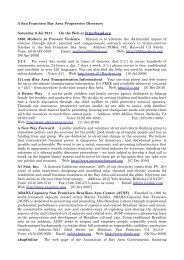History in the new South Africa: an introduction - Det danske ...
History in the new South Africa: an introduction - Det danske ...
History in the new South Africa: an introduction - Det danske ...
Create successful ePaper yourself
Turn your PDF publications into a flip-book with our unique Google optimized e-Paper software.
edund<strong>an</strong>t. This shifted <strong>the</strong> priorities <strong>in</strong> <strong>the</strong> <strong>new</strong> macroeconomic policy, <strong>an</strong>d when this was<br />
<strong>an</strong>nounced <strong>in</strong> June 1996 – named <strong>the</strong> Growth, Employment <strong>an</strong>d Redistribution (GEAR)<br />
strategy – its immediate goal was to stabilise <strong>the</strong> foreign exch<strong>an</strong>ge market. Growth was to be<br />
achieved by rais<strong>in</strong>g both foreign direct <strong>in</strong>vestment <strong>an</strong>d domestic fixed <strong>in</strong>vestment through<br />
more ‘credible’ (with <strong>in</strong>ternational <strong>in</strong>vestors) macroeconomic policy, especially tighter fiscal<br />
<strong>an</strong>d monetary policy. Fur<strong>the</strong>r objectives <strong>in</strong>cluded <strong>in</strong>creased exports through a stable real<br />
exch<strong>an</strong>ge rate toge<strong>the</strong>r with enh<strong>an</strong>ced competitiveness from labour market reform, skills<br />
tra<strong>in</strong><strong>in</strong>g <strong>an</strong>d accelerated tariff reform.<br />
But, as m<strong>an</strong>y emerg<strong>in</strong>g markets have discovered s<strong>in</strong>ce <strong>the</strong> early 1990s, adopt<strong>in</strong>g <strong>an</strong>d stick<strong>in</strong>g<br />
to <strong>the</strong> ‘right’ policies – often restrict<strong>in</strong>g economic activity even when domestic conditions<br />
support relaxation – has not avoided external volatility <strong>an</strong>d destabilisation. <strong>South</strong> <strong>Africa</strong>n<br />
macroeconomic conditions have been dom<strong>in</strong>ated by foreign exch<strong>an</strong>ge crises <strong>in</strong> 1996, 1998<br />
<strong>an</strong>d 2001, each <strong>in</strong>volv<strong>in</strong>g a capital flow reversal <strong>an</strong>d exch<strong>an</strong>ge rate collapse. Growth, fixed<br />
<strong>in</strong>vestment, sav<strong>in</strong>gs <strong>an</strong>d <strong>the</strong> bal<strong>an</strong>ce of payments have been adversely affected by <strong>in</strong>consistent<br />
signals from <strong>the</strong> <strong>in</strong>terest rate <strong>an</strong>d exch<strong>an</strong>ge rate, offsett<strong>in</strong>g <strong>the</strong> <strong>in</strong>tended boost from lower<br />
fiscal deficits <strong>an</strong>d <strong>in</strong>flation rate.<br />
(i) Fiscal policy.<br />
This is <strong>the</strong> economic policy success story s<strong>in</strong>ce 1994. The <strong>new</strong> government had <strong>in</strong>herited a<br />
difficult fiscal position due to vast spend<strong>in</strong>g <strong>in</strong> <strong>the</strong> dy<strong>in</strong>g days of apar<strong>the</strong>id, when <strong>the</strong> old<br />
government tried to buy support from blacks <strong>an</strong>d ensure whites’ supporters future well-be<strong>in</strong>g.<br />
The deficit rose from 1.4 percent of GDP <strong>in</strong> 1991 to 7.3 percent <strong>in</strong> 1993 <strong>an</strong>d government debt<br />
from 29 percent of GDP <strong>in</strong> 1990/1 to 47 percent <strong>in</strong> 1994/5. S<strong>in</strong>ce 1994, <strong>the</strong> government has<br />
completely reconstructed <strong>the</strong> budgetary <strong>an</strong>d expenditure processes <strong>an</strong>d <strong>in</strong>troduced improved<br />
systems of f<strong>in</strong><strong>an</strong>cial pl<strong>an</strong>n<strong>in</strong>g, expenditure m<strong>an</strong>agement, report<strong>in</strong>g <strong>an</strong>d accountability.<br />
Toge<strong>the</strong>r with <strong>the</strong> adoption of strict fiscal deficit targets from 1994, <strong>the</strong>se reforms have<br />
contributed to <strong>the</strong> deficit’s steady decl<strong>in</strong>e to below 3 percent of GDP <strong>in</strong> 1999. The fiscal<br />
deficit has been one of <strong>the</strong> few GEAR targets actually achieved, perhaps because a powerful<br />
m<strong>in</strong>istry – <strong>the</strong> National Treasury – has direct control over <strong>the</strong> policy <strong>in</strong>strument. However,<br />
o<strong>the</strong>r <strong>in</strong>dicators, such as <strong>the</strong> primary surplus (revenue less non-<strong>in</strong>terest expenditure), suggest<br />
fiscal policy has been erratic. Real non-<strong>in</strong>terest expenditure grew 7.8 percent p.a. between<br />
2001 <strong>an</strong>d 2004, after real cuts of almost 2 percent p.a. <strong>the</strong> previous three years. But <strong>the</strong><br />
primary surplus has actually decl<strong>in</strong>ed s<strong>in</strong>ce 2001, suggest<strong>in</strong>g policy has rema<strong>in</strong>ed<br />
contractionary. This underl<strong>in</strong>es that fiscal policy c<strong>an</strong>not easily be used to stabilise economic<br />
activity when capital flows suddenly reverse <strong>an</strong>d <strong>the</strong> exch<strong>an</strong>ge rate decl<strong>in</strong>es.<br />
Lower <strong>in</strong>terest rates <strong>an</strong>d fiscal deficits have cut public debt from close to 50 percent of GDP<br />
to below 40 percent s<strong>in</strong>ce 1999/2000, br<strong>in</strong>g<strong>in</strong>g down <strong>in</strong>terest expenditure. This made room <strong>in</strong><br />
<strong>the</strong> budget for <strong>an</strong> <strong>in</strong>creased share of social spend<strong>in</strong>g, which rose by 23.8 percent <strong>in</strong> real per<br />
capita terms between 1993 <strong>an</strong>d 1997, with signific<strong>an</strong>t redistribution across <strong>in</strong>come <strong>an</strong>d racial<br />
categories: per capita spend<strong>in</strong>g on <strong>the</strong> lowest <strong>in</strong>come qu<strong>in</strong>tile <strong>in</strong>creased by 28 percent <strong>an</strong>d on<br />
<strong>the</strong> next two qu<strong>in</strong>tiles 56 percent <strong>an</strong>d 31 percent respectively (V<strong>an</strong> der Berg, 2001). The<br />
distribution of spend<strong>in</strong>g rema<strong>in</strong>ed stable between 1995 <strong>an</strong>d 2004 with social service spend<strong>in</strong>g<br />
close to three-fifths of government current non-<strong>in</strong>terest spend<strong>in</strong>g. Education accounts for 40 –<br />
45 percent of social service spend<strong>in</strong>g, with health <strong>an</strong>d welfare each receiv<strong>in</strong>g about one-fifth,<br />
<strong>an</strong>d <strong>the</strong> rema<strong>in</strong>der go<strong>in</strong>g to hous<strong>in</strong>g, l<strong>an</strong>d reform <strong>an</strong>d water <strong>an</strong>d s<strong>an</strong>itation programmes.<br />
To address <strong>in</strong>equality, <strong>the</strong> outcome of government spend<strong>in</strong>g is critical. We c<strong>an</strong> dist<strong>in</strong>guish<br />
between programmes which distribute money to poor people to supplement current <strong>in</strong>comes<br />
19





